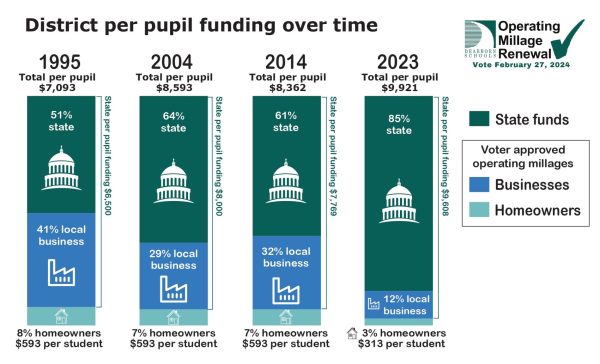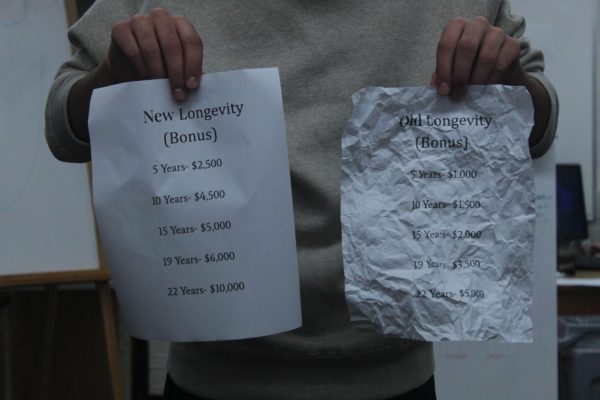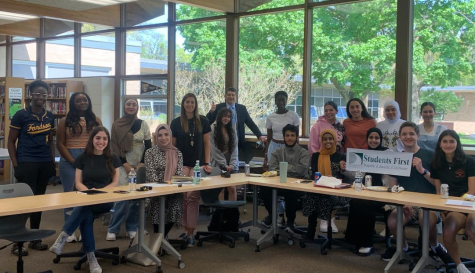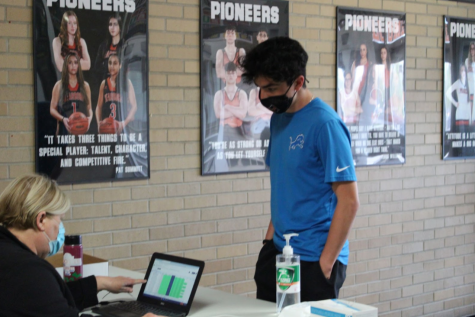Dearborn Public Schools confronts obstacles with virtual learning
On Nov.15, 2020, Michigan’s governor, Gretchen Whitmer, and her administration implemented a statewide shutdown through Dec. 9, 2020. From Nov. 9, 2020 to Nov.13, 2020, the COVID-19 cases in Michigan were at 35,009. In those few days, Michigan broke the daily record three times. From Nov. 9 to Nov.13, there were 4,910 total cases in Wayne County. Since then, students, parents, teachers, and administrators have been working together to figure out the best way to approach education through this pandemic.The shutdown put an end to all learning in person, closed workplaces if the work can be done at home, ordered bars and restaurants to be closed for dine in, and completely closed movie theaters and casinos.
DHS Assistant Principal Kelly Dear said that the administration team has been focused this year on making informed decisions with students and parents in mind.“We want to consider the effect on students and teachers when we choose to make changes,” Dear said. “The last thing we want to do is make reactionary changes every couple weeks, and create confusing or conflicting messages or procedures for students and parents who may be struggling or establishing a routine with the present process.”
William Harrison, a World History teacher at DHS, said he is most concerned about the current plan to best help struggling students. “I worry most about the students who don’t have a support system through this whole thing,” Harrison said. “I also worry about the students who are not self-motivated. A large number of students are not performing and participating academically, because they do not have the structure of a typical school day, and a teacher standing over their shoulder ‘pushing them along’.”
Susan Levasseur is a parent of a DHS student. She said that online learning has been both negative and positive for her child. “It has forced my student to be more organized and deadline oriented. They have had to take a more active role in their learning; sometimes teaching themselves the information, attending help sessions on their own, or seeking out peers from their classes for extra help,” Levasseur said. “On the negative end, it has changed their daily routine from waking up early in the morning to go to school to being able to sleep in. It also has been conducive to the ‘stay up all night to do work’ syndrome that then turns into sleeping in later and later.”
Carrie Conn, the school nurse at DHS, said it is not likely that students will be back in person anytime soon.“I do believe the amount of people who are testing positive in the community is way too high to anticipate students being back in the buildings after December and possibly well into January. The positivity rate for Wayne County is at 14.1%. In order to be in person, the positivity rate needs to be less than 5%,” Conn said.
Senior, Fatima Faraj, said one of the ways she’s coped with having to learn on-line is by doing her best to try to limit distractions. “I bought a planner, and it has made it really easy to make sure I keep time for each class,” Faraj said. “When I need to study, I try to delete my social media so that I don’t get distracted. Then, when I’m done with everything, I download everything back.”
Dearborn Public Schools has a campaign called “Mask Up Dearborn”. This campaign is dedicated to the community following protocol in order to slow the spread of COVID-19 in Dearborn, so that in person instruction can be implemented as soon as possible.











